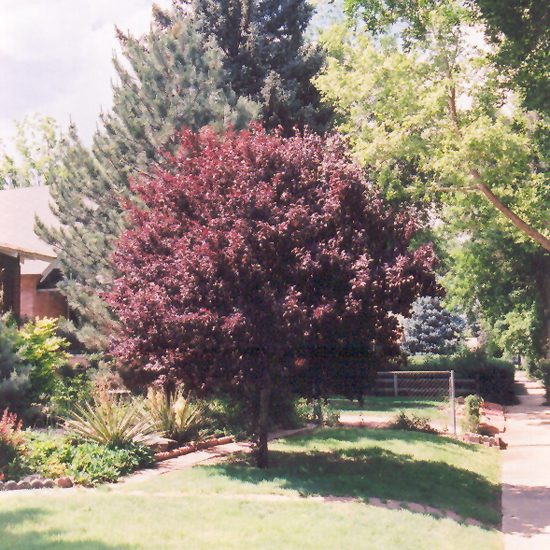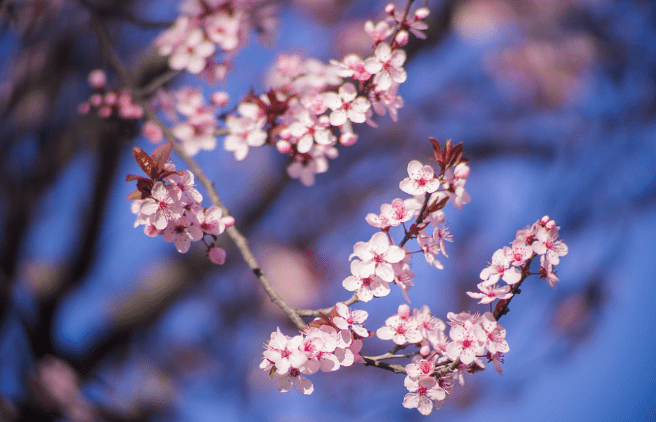
Flowering Ornamental Plum Prunus cerasifera
The tree you love but shouldn’t plant!
The flowering plum is a tree that so many people love to plant in their yard. And what’s not to love about it’s dark purple foliage and pretty whitish pink flowers in the spring? Its’ smaller stature makes it suitable for even small yards, small urban tree pits and even is great for under the power lines. It doesn’t produce edible plums, rather small little berries that the birds eat before they can even litter the ground. It also has great urban stress and drought tolerance. There are several cultivars of this tree available such as ‘Thundercloud’, ‘Autropupurea’ and ‘Krauter Vesuvius’.
It sounds great on paper and the small ones look so nice in the nursery, but there are so many cons to planting this tree, that it is a really poor investment in your landscape.

While it was bred by scientists for the lovely characteristics listed above, there are many fatal flaws as a result of that breeding.
- Structurally, the tree has very acute crotch angles between branches. This makes the branches more prone to failure and almost always after about 15-20 years the tree will split. Large branches or portions of the tree will fail. And if it doesn’t by some miracle split in two, it will probably just tip right over at some point.
- It has a very shallow, small root system. It is so small in proportion to the top foliage of the tree that it easily uproots and blows over in storms. Because of the disproportion between the canopy and the root system, plum trees need to be pruned and reduced in size frequently, otherwise they become too top heavy for their little root systems to hold them up. Most plums you will see around town are often permanently anchored to survive.
- Black Knot! This is a fungus that plugs up the vascular tissue of the tree and causes stem and branch death, eventually tree death. There is no cure for black knot, and every plum tree will end up with this disease at some point. Some plum trees are genetically stronger than others, so some will be more severely affected. Black knot looks just like it sounds, like large lumps of black all along the stems and branches.
-
- Scales! Scale insects love the flowering plum tree. From white prunicola scale to oystershell scale these insects love to feed on plum tree. They are also hard to get rid of and manage once the tree becomes infested. Management requires a battery of treatments, and who has the time or budget for that?
- Foliar leaf diseases! From shot hole blight, to anthracnose to powdery mildew, there are a myriad of leaf diseases that can really take away the beauty of a flowering plum tree. In rainy springs we see high infection levels of these diseases which all cause defoliation of the tree by mid-summer. A barren tree in July just isn’t that pretty.
There are many other choices of trees and shrubs that can add pink flower and burgundy/red/purple foliage to the landscape.
Forest Pansy redbud. Cercis canadensis ‘Forest Pansy’ is top on my list of an alternative to the flowering plum. This is a cultivar of the native eastern redbud that has purple to burgundy foliage all year round and pink/magenta/purple flowers in the early spring before the leaves emerge. This tree is a great way to bridge the gap between winter and full on spring. This is a moderately growing tree that can reach sizes of 20’ tall by 25’ wide.
Rancho Sargeant Cherry, Prunus sargentii ‘Rancho’ is also a great choice. It has clusters of single pink flowers early in the spring before foliage that emerges a reddish bronze and turns to glossy green during summer. The fall color is a striking mix of yellow, orange and red. It has wonderful disease resistance compared to other trees in the prunus family. This is a great tree that is drought resistant and makes a great small garden or street tree.
Purple Smokebush, Cotinus coggygria ‘Royal Purple’
This is a wonderful large woody shrub that has a deep purple/red foliage throughout the year. During summer it sprouts amazing pinkish/purple flowers that look like puffs of smoke. It then turns a nice scarlet in the fall. It is very cold hardy, drought and heat tolerant ant and very insect and disease resistant. While it is technically a shrub, it gets up to 15’ tall and can be pruned to appear like a tree.
Crabapple, Malus several cultivars including ‘Perfect Purple’ and ‘Royalty’
‘Perfect Purple’ is a modest size tree growing to 20-25’H and 15-20’ wide at maturity. It has an upright habit and purple foliage that gives way to bright pink flowers. The foliage turns a striking red in the fall as well. It attracts birds and pollinators and is also salt tolerant.
‘Royalty’ grows 15-20’ high and wide, loves the sun and fertile well-drained soils. Looks great as a specimen plant. It has a dense spreading habit and has dark purple leaves. The flowers emerge after the leaves and are a vivid red and fragrant. After the flowers follow a very dark red fruit that the birds and wildlife devour.
Japanese maple, Acer palmatum var. atrupurpureum ‘Bloodgood’
This tree has attractive burgundy red foliage that turns scarlet in the fall. It likes full sun to filtered shade. Its bark provides great winter interest. It is a slender airy tree that is good for small lawns and patios. It is one of the hardiest Japanese maples with good sun tolerance.
Black Elderberry Sambucus nigra ‘Black Lace’
It’s not a tree, but I had to include it on my list of purple leaf plants. It has intensely purple black foilage that is deeply cut like lace. It reminds some of lace leaf Japanese maple. The pink flowers don’t emerge until early summer, which is a nice change from all the early spring pink blooms we see in the garden. The contrast between the pink flowers and the dark foliage is just stunning. This large shrub will get 8’x8’ at maturity and is rugged, durable and adaptable.


